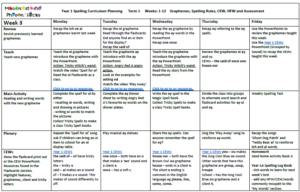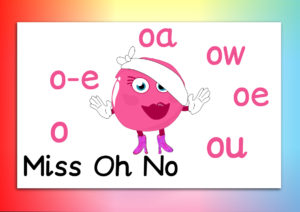Termly and Weekly Plans
Easy to follow planning guides you through the lesson and how to use the resources. Planning follows the DfE Letters & Sounds and the KS1 Curriculum. In addition to phonics, it specifies the high-frequency or common exception words to be taught each week. Planning also shows where and how to carry out formative assessments and allows opportunity for review.
PowerPoint
Each lesson begins with an introductory PowerPoint, the first page of which reviews the grapheme of the sound. Here is an example of Miss Oh No’s long O graphemes. Posters like this can be downloaded from the Print Material section.
Monster Phonics is systematic in its teaching and organisation, making teaching easier and more memorable. In Monster Phonics the graphemes are ordered according to their frequency, from the most common on the left to the least common on the right. The open syllable graphemes, such as this ‘o’ here, are always the most common graphemes in general text. However, in children’s reading material the split digraph is actually the most common.
The PowerPoint provides opportunities for reading and highlights spelling rules and features, such as the common position of the grapheme in words and how pronunciation or spelling may change with tense. The last page outlines the main activity, which is described in detail in the Lesson Plan.
The PowerPoint refers to a Monster Phonics video, song or story available on this resource page. Each video, song or story focuses on the word list. This helps children to associate a specific set of words (the most common) with a particular grapheme and reduces confusion between different long vowel spellings, such as ai and a-e. Each sound and monster also has an associated action shown in this video.
Main Activity
The main activity also focuses on the word list and encourages children to read and spell the specific words in order to remember them. As Monster Phonics is more multisensory than other schemes, employing colour-coding for sound, colour can be used to support learning. This is ideal for the KS1 and Reception environment. It makes learning exciting and memorable.
Monster Phonics Lesson Plans also have a level of differentiation, with activities to support learners who find phonics most challenging and extension activities which normally focus on grammatical advances.
Flashcards
Flashcards can be used as support during the main activity or for additional flashcard games. Here is a list of Monster Phonics Flashcard Activities.
Asking the children to record the words that they have found, jumped on or hit provides further writing as well as reading opportunity.
The 300 High-Frequency Word Flashcards and the Common Exception Word Flashcards can also be downloaded from the Flashcard section at the top of the Resources page.
Nonsense Flashcards
Useful preparation for the Phonics Screening Check, these flashcards show ‘aliens’ to indicate that the word shown is not real. Remember that a variety of pronunciations are acceptable as part of the test.
Songs and Videos
Songs and videos help to link the correct set of words with a specific grapheme. The plenary of each lesson often replays the song or video. Also sing the songs at times outside of the phonics lesson to consolidate learning. Lining up, walking to lunch/games and settling down times are ideal opportunities to sing a known Monster Phonics song. Every word in the word list has been selected because it is an important word for children to learn for improved progress.
Word Search
This is useful for reviewing the word lists. Word searches are also available for high-frequency and common exception words.
Other Resources
Monster Phonics has downloadable posters, flashcards, display and assessment material.
Meet the Monsters
Every fun, engaging element of Monster Phonics has a learning advantage. Children love the monsters who are actually sound cues to help children to link spelling and sound. This video introduces each Monster and their sounds and graphemes.


